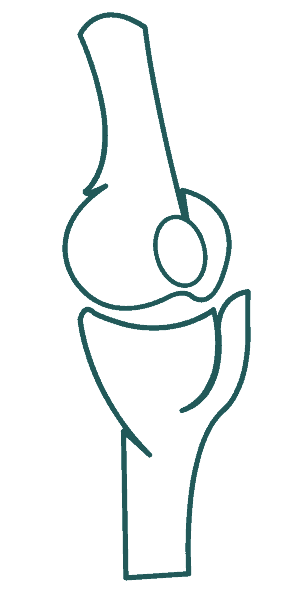Has your dog developed a sudden limp in one leg? There could be a number of causes, but chances are that they’ve injured a cruciate, also known as the CCL (Cranial Cruciate Ligament).
The reason for this is that cruciate disease in dogs is one of the most common orthopaedic conditions that veterinarians will see.
But what’s even more concerning is that over half of dogs who’ve had some form of cruciate problem will experience similar symptoms in the other leg1.
Seeing them struggle is heart-wrenching, but you’re not alone.

within 2.5 years most dogs will rupture their other cruciate
The Cranial Cruciate Ligament (CCL) is the main stabilising ligament inside the stifle (knee) of an animal. It performs a similar function as the Anterior Cruciate Ligament (ACL) in humans. The CCL is crucial to normal stifle function. It aids to resist shock, twisting, and shear forces back and forth.
When the cruciate ligament tears, besides causing a tremendous amount of pain, the stifle also loses it’s structural integrity and renders the stifle unstable and unable to function properly.
When this injury is merely mentioned, it brings tears to one’s eyes, because of how serious (and expensive) it is to x.
The cruciate can tear for a number of reasons, but usually, it’s the result of a slow degenerative process that happens over time. This leads to the cruciate becoming weaker, which is then more susceptible to a traumatic episode.
The classic presentation is a dog limping on of its hind legs after physical activity such as sharp turning/stopping when chasing a ball, twisting the stifle, jumping off something, or after playing with another dog. However, it’s not always like this. Sometimes you won’t know what happened, and other times dog won’t show any obvious signs at all.
These are the more common symptoms, but your dog may experience other symptoms, or sometimes very little symptoms. Also note, that just because your dog is experiencing some or all of these symptoms, it doesn’t mean that a cruciate is definitely the problem – always seek a professional diagnosis.

If a surgical procedure is recommended, the type of surgery will depend on several factors such as the size of your dog, cost, preference of the veterinarian, or availability of specialist surgeons. There are more options than listed below, but the ones listed below are the most common.
Conservative veterinary treatment consists of everything else that isn’t surgery. Each case is patient-specific, but may include some of the following:
Rehabilitation is a very important, yet often overlooked part of the recovery journey. It’s still the common advice that if the surgery has gone well, no rehabilitation is needed.
Now imagine that you had some major surgery on your own knee, and your surgeon had suggested that everything had gone so well that you don’t need any physio or exercise – just bedrest for 6-8 weeks, then off you go.
You already know that’s terrible advice and you’d probably be heading off to get a second opinion. It’s been many decades since bedrest has been recommended – in fact most orthopaedic operations have you starting your rehab process the very next day.
At the Animal Rehab Klinik, our mission is to get more vets to understand the importance of rehabilitation and recommend it for all of their patients.
Rehabilitation has been a major part of the recovery process with humans since the 1950s. Research shows that when it comes to humans rupturing their cruciate (ACL), rehabilitation is essential to ensure the surgery goes well, and more recently there’s strong evidence showing that a full recovery can be made without surgery. We’re not suggesting that this would be the same for dogs, but it’s interesting to know how effective a good rehabilitation program can be!
In most cases, rehabilitation will be an adjunct to the veterinary care that was mentioned on the previous page. Whether your dog gets surgery or not, a rehabilitation provider should have a good rapport with your veterinarian, and tailor their program not just to suit the patient, but to work with the veterinarian to achieve common goals.
There are many different modalities of treatment that can be implemented to best support recovery and ensure the best functional outcomes after cruciate injury and surgery. It depends on what stage of recovery your dog sees us and what the goals are, Some of the common approaches we use are
Used to condition them prior to surgery. We don’t do a lot of prehab before cruciate surgery as you want to minimise stifle movement as much as possible. However it can still be worthwhile to learn some of the basic massages & stretches for now & post-op, do some gentle treatments such as laser to help manage pain and inflammation and purchase any supplements and rehab devices you think you’ll need.
This can be started right after surgery (despite many vets still suggesting you need to wait 6-8 weeks). The confusion here is that rehab can mean a lot of things. If your rehabilitation provider knows what they’re doing, they’ll be able to advice the right kind of rehab for the stage of healing.
Rehab is a generic term that can mean anything from physiotherapy, chiropractic, osteopathy, exercises, laser, hydrotherapy, massage and anything else that we do to promote recovery.
It’s much easier to rehab something early if it’s looking that it could be problematic, rather than waiting for your 6-8 week vet checkup & then being told that it didn’t go to plan and now you should try to do some rehab to hopefully avoid a corrective surgery.
Those 6-8 weeks ps valuable time when you could have been doing something to give your dog a better chance at recovery.
We typically won’t start this till 2-3 weeks post op once the surgical wound has healed. The last thing you want is an infection. The great thing with the underwater treadmill is that buoyancy allows for reduction in pressure in the stifle. This means that your dog can actually go walking, while keeping the operated stifle protected.
It’s the same deal for a dog who hasn’t had an operation – now they can walk with less pain and less compensation than what they’re doing on land.
As your dog progresses the hydrotherapy gets more difficult, lowering water & increasing speed which gradually loads the stifle and gets those surrounding muscles nice & strong.
This is a great way to promote healing to an injured area. Just like plants get energy from the sun, the damaged cells in our body also absorb energy from the laser which leads to quicker healing. Some of the other effects of the laser include: increases circulation, reduced inflammation and reduced pain.
Who doesn’t love a massage? increases circulation, improves lymphatic flow for swelling, helps scar tissue healing, improves flexibility/mobility, and calms the nervous system. Massage is great for both the affected area and the other muscle groups which your dog is using to compensate.
Doga anyone? Just like massage, stretching is really useful for all the other areas of the body which are getting tight due to compensation. At the injured area we do more gentle movement, something known as PROM (passive range of motion) to help maintain movement in the operated joint.
You’ll have a lot of time in between appointments where you can get involved with your dog’s recovery. Plus, crate rest is incredibly boring for them, so they’ll love the extra attention. Usually, we start with the easy stuff like massage & stretching. Over time we add in more challenges by adding in more advanced exercises, all with the aim of getting them back as close as possible to their pre-injury function.
Cruciate recovery isn’t always straight forwards. We’re here with you along the journey to help find solutions for any difficulties that you’re having. If at any time things aren’t going to plan, we’ll let you know if you need to see the vet sooner than expected.
The journey to recovering from a CCL injury isn’t always straightforward. There can be complications, difficulty keeping your dog quiet in the early stages, especially if you have other dogs or young kids, and trouble keeping to the rehab program.
To give your dog the best chance of getting back on all paws, make a booking with us at Animal Rehab Klinik.